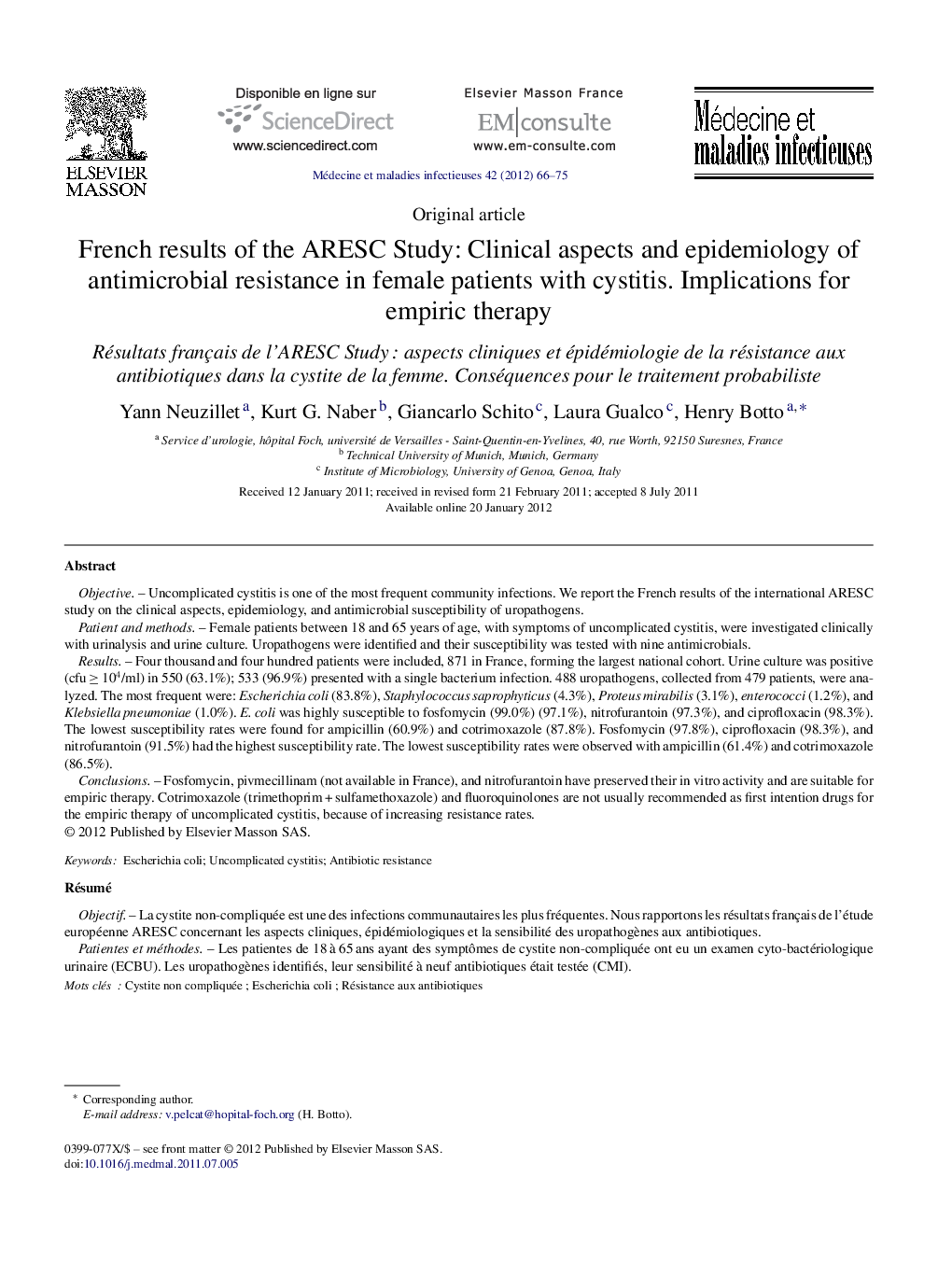| Article ID | Journal | Published Year | Pages | File Type |
|---|---|---|---|---|
| 3413015 | Médecine et Maladies Infectieuses | 2012 | 10 Pages |
ObjectiveUncomplicated cystitis is one of the most frequent community infections. We report the French results of the international ARESC study on the clinical aspects, epidemiology, and antimicrobial susceptibility of uropathogens.Patient and methodsFemale patients between 18 and 65 years of age, with symptoms of uncomplicated cystitis, were investigated clinically with urinalysis and urine culture. Uropathogens were identified and their susceptibility was tested with nine antimicrobials.ResultsFour thousand and four hundred patients were included, 871 in France, forming the largest national cohort. Urine culture was positive (cfu ≥ 104/ml) in 550 (63.1%); 533 (96.9%) presented with a single bacterium infection. 488 uropathogens, collected from 479 patients, were analyzed. The most frequent were: Escherichia coli (83.8%), Staphylococcus saprophyticus (4.3%), Proteus mirabilis (3.1%), enterococci (1.2%), and Klebsiella pneumoniae (1.0%). E. coli was highly susceptible to fosfomycin (99.0%) (97.1%), nitrofurantoin (97.3%), and ciprofloxacin (98.3%). The lowest susceptibility rates were found for ampicillin (60.9%) and cotrimoxazole (87.8%). Fosfomycin (97.8%), ciprofloxacin (98.3%), and nitrofurantoin (91.5%) had the highest susceptibility rate. The lowest susceptibility rates were observed with ampicillin (61.4%) and cotrimoxazole (86.5%).ConclusionsFosfomycin, pivmecillinam (not available in France), and nitrofurantoin have preserved their in vitro activity and are suitable for empiric therapy. Cotrimoxazole (trimethoprim + sulfamethoxazole) and fluoroquinolones are not usually recommended as first intention drugs for the empiric therapy of uncomplicated cystitis, because of increasing resistance rates.
RésuméObjectifLa cystite non-compliquée est une des infections communautaires les plus fréquentes. Nous rapportons les résultats français de l’étude européenne ARESC concernant les aspects cliniques, épidémiologiques et la sensibilité des uropathogènes aux antibiotiques.Patientes et méthodesLes patientes de 18 à 65 ans ayant des symptômes de cystite non-compliquée ont eu un examen cyto-bactériologique urinaire (ECBU). Les uropathogènes identifiés, leur sensibilité à neuf antibiotiques était testée (CMI).RésultatsSur 4400 patientes inclues, 871 l’ont été en France, constituant ainsi la plus grosse cohorte nationale. L’ECBU était positif (≥ 104/ml ufc) dans 550 (63,1 %) cas ; 533 (96,9 %) montraient un seul germe. 488 uropathogènes issus de 479 patientes ont été analysés. Les pathogènes les plus fréquents étaient E. coli (83,8 %), Staphylococcus saprophyticus (4,3 %), Proteus mirabilis (3,1 %), Entérococcus (1,2 %) et Klebsiella pneumoniae (1,0 %). Les sensibilités d’E. coli étaient : 99,0 % pour la fosfomycine, 97,1 % pour le pivmecillinam, 97,3 % pour la nitrofurantoïne, 98,3 % pour la ciprofloxacine, 60,9 % pour l’ampicilline et 87,8 % pour le cotrimoxazole. Pour l’ensemble des uropathogènes, la fosfomycine (97,8 %), la ciprofloxacine (98,3 %) et la nitrofurantoïne (91,5 %) avaient les taux de sensibilité les plus élevés. Les plus faible étaient observés avec l’ampicilline (61,4 %) et le cotimoxazole (86,5 %).ConclusionsLa fosfomycine, le pivmecillinam et la nitrofurantoïne ont conservé leur efficacité in vitro et peuvent être employés comme traitement probabiliste. En raison des taux de résistance accrus, le cotrimoxazole et les fluoroquinolones ne sont généralement pas recommandés en première intention pour le traitement probabiliste de la cystite non-compliquée.
